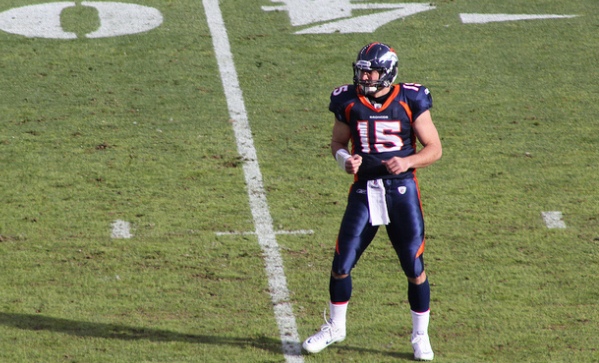Tim Tebow has quickly become a touchstone of American culture. It’s a not-too-surprising fact — after all, he is a starting quarterback in the NFL. But he’s name-dropped during GOP debates, and most tellingly, has a drinking game in his honour. The game’s rules succinctly capture both the athlete’s playing and persona: Drink when the announcer breaks down Tebow’s lack of accuracy, uses the word “win” to describe Tebow, or verbs the name Tebow. Other rules include drinking whenever Tebow points to the sky, and Tebowing whenever any player on the field does so. The last person to Tebow must finish everyone else’s beer.
Tebowing aside, what’s the story with the Denver Broncos quarterback, on the field? With a record of 7-3 in his last ten starts, here are the hard numbers (as of Dec. 28):
Passing average: 48.6%
Season-high, single game passing yardage: 202
Total rushing yards: 644
Placed in context:
Rookie quarterback Andy Dalton’s passing average: 59.0%
Number of passing yards Drew Brees averages in a single half: 188
Michael Vick’s total rushing yards (with more starts than Tebow): 586
With these numbers, we can comment with abandon. On the ground, Tebow is certainly fleet of foot. His build, speed and agility make him a second running back. This marks him as an “unconventional” quarterback who adds more running value to the position outside of Cam Newton this year, or Michael Vick in 2006. When it works, this style of play is exciting, though it leaves coaches and commentators tugging at their hairpieces — the Tom Bradys of the world stay in the pocket, throwing and handing off the ball.
In the air, Tebow’s passing — when he does throw — is lacking. His sidearm is mechanical and needs rethinking, it’s sluggish in its release and wobbly in its flight, providing cornerbacks more time to get to the ball. Yet, in clutch fourth quarter performances (Tebow Time), his throws miraculously tighten and bomb downfield.
Criticism notwithstanding, Tebow has won seven out of his ten starts this season. The question is: How far can we project such sophomoric fumbles and bad stats into Tebow’s career? Comparing him to past quarterbacks’ rookie statistics is one option. But the first problem with following numbers in sport is they don’t take variables into account. Variables in this case are players and their style of play. Which makes it difficult to compare one quarterback to the next, particularly among fresh-faced starters. Tebow’s rushing alone makes it impossible to compare his rookie season to those of Drew Bledsoe (47.4% completion percentage) or Eli Manning (a tickle ahead of Tebow’s percentage). Both went on to strengthen their play and develop careers beyond their rookie year — neither was/is known for his mobility.
The second problem with numbers is that Tim Tebow statistically defies statistics. Weeks ago, he edged the Broncs over the Bears by a paltry score of 13-10 in the dying moments of the game. After completing just three of 16 passes in the first three quarters, for a measly 45 yards, Tebow went on to throw 18 of 24 for 191 yards and one touchdown in the fourth quarter. The Broncs went on to win by Matt Prater’s 51-yard field goal in overtime. Tebow had led a similar comeback the week previous. On paper, pulling wins out of hats, with Tebow’s percentages and averages, makes little to no sense. Looking ahead, it seems he won’t be able to keep winning games this way — the Bills proved that on Christmas Eve.
Football, any sport nowadays, wades in a glut of statistical information that muddies a quality that Tebow has, and that sports fans love. He does something to feed our obsession with highlights reels — something like heroic movie montages — he beats the odds.
Here’s what we don’t know: How the hell he does it.
——————–
Image courtesy of Jeffrey Beall.


